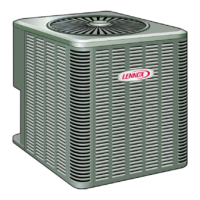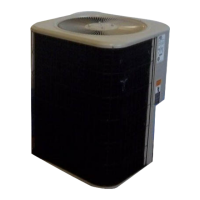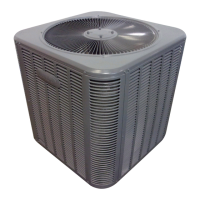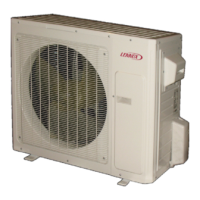able to close the manifold gauge valve at least once to
determine ifthere is a rapid rise in absolute pressure,
A rapid rise in pressure indicates a relatively large
leak, If this occurs, repeat the leak testing procedure,
NOTE - The term absolute pressure means the total
actual pressure within a given volume or system,
above the absolute zero of pressure. Absolute pres-
sure in a vacuum is equal to atmospheric pressure mi-
nus vacuum pressure.
6, When the absolute pressure reaches 23,000 microns
(29.01 inches of mercury), close the manifold gauge
valves, turn off the vacuum pump and disconnect the
manifold gauge center port hose from vacuum pump.
Attach the manifold center port hose to a nitrogen cyl-
inder with pressure regulator set to 150 psig (1034
kPa) and purge the hose. Open the manifold gauge
valves to break the vacuum in the line set and indoor
unit, Close the manifold gauge valves,
WARNING
I
NOTE - After the system has been evacuated and before
completing all the remaining start-up steps, this is the ideal
time to adjust the amount of refrigerant made necessary by
line set length difference and by the specific indoor unit
matchup. Skip to the paragraph "Setup for Checking and
Adding Charge" on Page 13 to setup for charging and for
determine if charge is needed; adjust the charge accord-
ingly
3, Open the liquid line and vapor line service valves
(counterclockwise) to release refrigerant charge (con-
tained in outdoor unit) into the system,
4, Replace stem caps and tighten finger tight; then tighten
per table 1 (on page 2),
5, Check voltage supply at the disconnect switch. The
voltage must be within the range listed on the unit
nameplate. If not, do not start the equipment until the
power company has been consulted and the voltage
condition has been corrected.
6, Set the thermostat for a cooling demand, turn on pow-
er to indoor blower unit and close the outdoor unit dis-
connect to start the unit,
7, Recheck voltage while the unit is running. Power must
be within range shown on the nameplate,
7. Shut off the nitrogen cylinder and remove the manifold
gauge hose from the cylinder. Open the manifold
gauge valves to release the nitrogen from the line set
and indoor unit.
8. Reconnect the manifold gauge to the vacuum pump,
turn the pump on, and continue to evacuate the line set
and indoor unit until the absolute pressure does not
rise above 500 microns (29.9 inches of mercury) within
a 20-minute period after shutting off the vacuum pump
and closing the manifold gauge valves.
9. When the absolute pressure requirement above has
been met, disconnect the manifold hose from the vac-
uum pump and connect it to an upright cylinder d
HFC-410A refrigerant. Open the manifold gauge
valves to break the vacuum from 1 to 2 psig positive
pressure in the line set and indoor unit, Close manifold
gauge valves and shut off the HFC-410A cylinder and
remove the manifold gauge set,
A IMPORTANT
1. Check that fan rotates freely.
2. Inspect all factory and field-installed wiring for loose
connections.
This system is charged with HFC-410A refrigerant which
operates at much higher pressures than HCFC-22. The
recommended check expansion valve is approved for use
with HFC-410A. Do not replace it with a valve that is de-
signed to be used with HCFC-22. This unit is NOT ap-
proved for use with coils that include metering orifices or
capillary tubes,
The unit is factory-charged with the amount of HFC-410A
refrigerant indicated on the unit rating plate, This charge is
based on a matching indoor coil and outdoor coil with a 15
foot (4,6 m) line set. A blank space is provided on the unit
rating plate to list the actual field charge,
A IMPORTANT
NOTE - Be sure that filters and indoor and outdoor coils are
clean before testing.
COOLING MODE INDOOR AIRFLOW CHECK
Check airflow using the Delta-T (DT) process (figure 16),
HEATING MODE INDOOR AIRFLOW CHECK
Blower airflow (CFM) may be calculated by energizing
electric heat and measuring:
• temperature rise between the return air and supply air
temperatures at the indoor coil blower unit,
• measuring voltage supplied to the unit,
• measuring amperage being drawn by the heat unit(s),
505325 03/08
Page 12
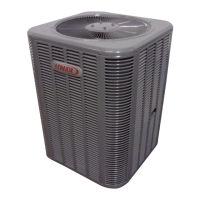
